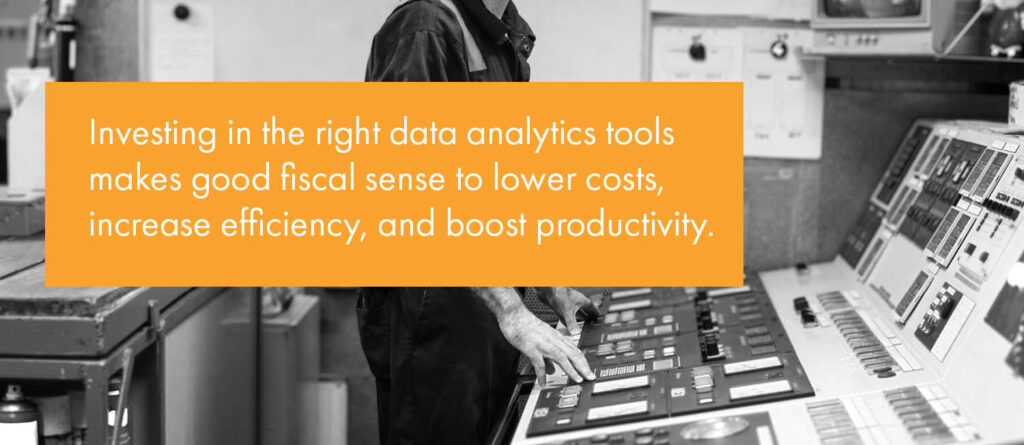As data analytics revolutionizes the barge industry, inland marine revenue is poised for growth from $132 billion in 2023 to a projected $185 billion in 2033 , according to the 2023 global forecast in the Barge Transportation Market report compiled by The Brainy Insights. New technology becomes a change agent as more traditional means for handling data create points of struggle in today’s more-complex barge industry. Investing in the right data analytics tools makes good fiscal sense to lower costs, increase efficiency, and boost productivity.
Two Examples Where Analytics Can Change the Barge Industry for the Better
While there are numerous ways that the right analytics can help a transport company, it might be instructive to look at two areas that have changed radically in the past ten years or so: Automating data-gathering and analytics for financial reports and decisions, and making adjustments in the face of low water levels.
Automating Analytics for Financial Reports and Decisions
Keeping the industry at peak performance is where automation excels. In inland marine, automation reduces the reliance on traditional paperwork while also providing a more accurate financial picture for the long term.
For example, automation and AI can cut down the time barge owners use to work out time-consuming financials. In the past, traditional data was pulled from a variety of sources and compiled into a spreadsheet—usually, to calculate profits and losses. But today’s data-gathering techniques and analytics reports allow for a much more sophisticated kind of decision-making.
For example, automation can quickly calculate:
- Which barges are generating the most revenue or which barges are costing money with repeated maintenance issues or crew problems.
- Critical stats, such as average barge revenue per trip day, barge trip average duration, and other measures such as total miles, load miles, empty miles, total shifts, total delays.
- Work schedules of office staff, barge crews, and the finances involved in making sure barges are prepared for any delivery under any conditions.
- Which marine terminals may be unable to accommodate barges due to aging infrastructure or remote locations.
- How much revenue is lost during a lock delay.
Making Adjustments in the Face of Low Water Levels
Dealing with low water levels is another example. Low water levels along major rivers (such as the Mississippi River) and unstable weather present challenges for both the long-term and short-term health of a barge transport company. The good news is that data analytics helps the barge industry navigate these shallow waters (both figurative and literal). Here are three things that work:
- Calculating lock delay times that could impact deliveries.
- Managing and tracking fleets with the ability to instantly pinpoint the location of a vessel anywhere.
- Up-to-the-minute updates on water levels. Special software can alert barge crews when water levels can no longer support large barges. With advanced knowledge of changing conditions, barge operators and crews can safely avoid trouble spots.
In short, data analytics can make projections to maximize information that keeps operators in the know on current and future conditions and issues that could affect operations. And most importantly, this data can be gathered constantly, every day, so that whenever a decision is needed, it can be made with accurate, up-to-date information.
Between accurate, timely data and the ability to automate various kinds of reporting, much less time is spent hunting down answers to important questions. And timely decisions ultimately have a huge impact on an operation’s bottom line .

The Tools of Big Data
Automation is just one part of the Big Data revolution in the barge industry. Other advances are happening in:
The Use of AI
While automation is used to do routine, repetitive tasks that take up valuable time, AI is a newer set of tools that excels at completing big, complex calculations. For example, Big Data using AI can quickly perform cost analyses and comparisons .AI algorithms can also be instrumental in providing a more clear-cut picture of a barge’s operations, safety, and on-time delivery protocols. Some researchers are even working on tools that can check for inaccuracies and fraud in the forms and contracts that the barge business traffics in.
GPS Systems
GPS systems can be used to more accurately track vessels, pinpointing their locations and correlating that information with data on known obstacles that could slow down transit. Armed with Big Data precision, barge operators are less likely to be dinged by insurance companies for situations that seem to arise under conditions outside of a barge captain’s control.
How BargeOps can Help
These examples show just a few areas where Big Data analytics can help a barge transport company. But they are not the only ones. What we have found here at BargeOps is that every company’s data and reporting needs are different.
This is why we work hard to ensure that our software can do just that. Our team will work with yours to create just the custom reports your business needs, and ensure that they can be delivered when needed, reflecting the most accurate and up-to-date information. And if the standard reports work well for your company out of the box, you can use those, too.
To learn more, we invite you to check out the
BargeOps analytics module . We would be happy to demo it for you!

